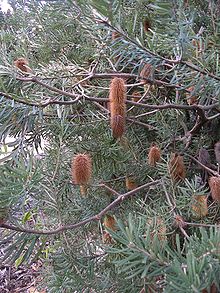Banksiamyces
| Banksiamyces | |
|---|---|

| |
| Berkeley and Broome's 1887 drawings of various Australian fungi, including Tympanis toomansis (#s 18–22) | |
| Scientific classification | |
| Domain: | Eukaryota |
| Kingdom: | Fungi |
| Division: | Ascomycota |
| Class: | Leotiomycetes |
| Order: | Helotiales |
| Family: | Helotiaceae |
| Genus: | Banksiamyces G.W. Beaton |
| Type species | |
| Banksiamyces macrocarpus G.W. Beaton
| |
| Species | |
Banksiamyces is a
Taxonomy
In 1887, English mycologists Miles Joseph Berkeley and Christopher Edmund Broome described a species of fungus they named Tympanis toomansis, collected from dead infructescences ("cones") of Banksia growing on the banks of the Tooma River in southern New South Wales, Australia. Its generic placement was a result of its resemblance to Tympanis, a genus in the family Helotiaceae of the Ascomycota.[1]

Additional collections, then still believed to be T. toomansis, were made from South Australia in 1952, again on dead cones of unspecified Banksia, and also in 1956 on dead cones of Banksia marginata. In 1957 and 1958, R. W. G. Dennis redescribed the species, and after consultation with Canadian mycologist James Walton Groves, who had earlier completed a monograph on the genus Tympanis,[2] transferred the taxon to the genus Encoelia (family Sclerotiniaceae).[3][4] Encoelia species are small, tough, brownish discomycetes that typically grow in clusters on hardwood or woody substrates.[5] Because the original collections were incomplete and certain microscopic features inadequately described, various collections made from Australia were presumed to be variations of the original 1887 collection.[4]
In the 1980s, the availability of fresh specimens of the fungus—collected by Australian mycologist
Banksiamyces is
Description
The fruit bodies, or
The
Species

B. macrocarpus grows on the dead cones of Banksia spinulosa, and was first collected near Tonimbuk, Victoria in 1981. It is the type species of Banksiamyces.[6][13]
B. toomansis is the species originally described and illustrated by Berkeley and Broome. The type collection was found on a cone of Banksia marginata on the banks of the Tooma River of New South Wales.[1][6] It has also been recovered from a cone of Banksia sphaerocarpa from near Busselton in Western Australia, B. nutans, B. pulchella, B. speciosa, and B. occidentalis, all from Mount Merivale, 20 km (12 mi) east of Esperance, B. baxteri cultivated at Cranbourne Botanic Gardens, B. integrifolia from the Blue Mountains, and B. marginata from Kangaroo Island.[8] Synonyms include Tympanis toomansis Berk. & Br., and Encoelia toomansis (Berk. & Br.). Its ascospores can range in shape from elliptical to cylindrical, and have dimensions of 6–10 by 2.5–3 μm.[4]
References
- ^ . Retrieved 2010-02-18.
- doi:10.1139/b52-042.
- JSTOR 4113703.
- ^ JSTOR 4109542.
- ^ Iturriaga T. (1994). "Discomycetes of the Guayanas .1. Introduction and some Encoelia species". Mycotaxon. 52 (1): 271–88.
- ^ .
- ^ .
- ^ a b Sommerville K, May T (2006). "Some taxonomic and ecological observations on the genus Banksiamyces". Victorian Naturalist. 123 (6): 366–75.
- ISBN 978-0-85199-826-8.
- ISBN 978-0-85199-827-5.
- ^ Zhuang W.-Y. (1988). "A new species of Dencoeliopsis and a synoptic key to the genera of the Encoelioideae". Mycotaxon. 32: 97–104. Retrieved 2010-02-18.
- ISBN 978-1-876473-68-6.
- ^ "Genus Record Details: Banksiamyces". Index Fungorum. CAB International. Retrieved 2010-02-18.
